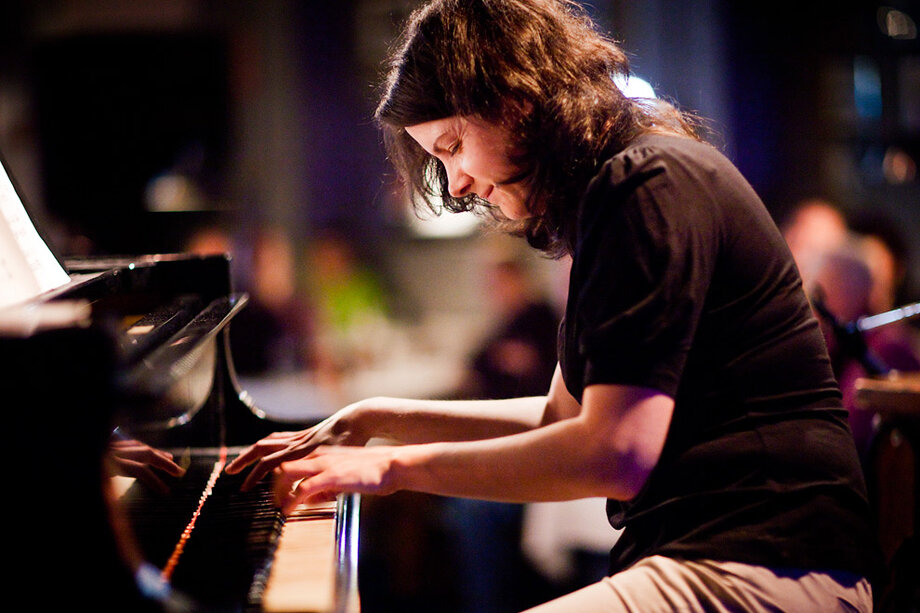Kris Davis Speaks
 2011 was a strong year for pianist Kris Davis. Her work was featured on two head-turning releases on Clean Feed: Aeriol Piano, her own solo album, and Novela, the eponymous release by a band led by Tony Malaby for which she also did the arrangements (they performed here recently). Aeriol Piano received several year-end accolades. Ben Ratliff of The New York Times listed the release as one of the Best Albums of 2011, and also profiled Kris in "New Pilots at The Keyboard", an article about four jazz pianists on the rise.We took note of Kris' work last year in performances by Paradoxical Frog (the trio she co-leads with the saxophonist Ingrid Laubrock and drummer Tyshawn Sorey) and Novela, and we look forward to her first performance under her own name at The Gallery on Thursday.Below, Kris shares and discusses examples of the work of some of her favorite pianists, composers, and improvisers. Kris speaks:
2011 was a strong year for pianist Kris Davis. Her work was featured on two head-turning releases on Clean Feed: Aeriol Piano, her own solo album, and Novela, the eponymous release by a band led by Tony Malaby for which she also did the arrangements (they performed here recently). Aeriol Piano received several year-end accolades. Ben Ratliff of The New York Times listed the release as one of the Best Albums of 2011, and also profiled Kris in "New Pilots at The Keyboard", an article about four jazz pianists on the rise.We took note of Kris' work last year in performances by Paradoxical Frog (the trio she co-leads with the saxophonist Ingrid Laubrock and drummer Tyshawn Sorey) and Novela, and we look forward to her first performance under her own name at The Gallery on Thursday.Below, Kris shares and discusses examples of the work of some of her favorite pianists, composers, and improvisers. Kris speaks:
Patterns in a Chromatic Field – Morton FeldmanThis is one of my favorite pieces of all time. The way the piano and cello interact as a harmonic and melodic unit is the reason I come back to this piece again and again. Because each cell is repetitive within itself, you really have a chance to get inside the sonority of the instruments and the way they interact- sometimes as a unit, sometimes as separate entities. Rhythmically, some of the sections seem to be rooted in two different pulses, which is an effect that I have tried to use in my own compositions and when improvising.Berio Sequenza IV for PianoI first discovered Berio a couple years ago while studying with composer Jonathan Pieslak. Berio wrote solo pieces for various instruments and, although I’m partial to the piano sequenza for obvious reasons, I also love the oboe and viola sequenzas. In this piano piece, Berio creates various tiers of harmony and density that seem to overlap, unveiling themselves in sudden bursts and spaces. Dynamics, the attack of the notes, and the sostenuto pedal all help to create these effects. There are so many levels going on. When I listen to this piece, I am constantly trying to figure out how the sound is created, but at the same time, I am completely centered in the sound.Benoit Delbecq – Circles and CalligramsI think Benoit is one of the most unique pianists and composers of our generation. The way he orchestrates piano preparations to emphasize or obscure polyrhythms, his touch at the piano, and the effect he creates combining these elements is definitely something to experience if you haven’t already.Rytis Mazulis – SybillaRytis is a Lithuanian composer. I first heard his piece ‘Clavier of Pure Reason’ which seems to be influenced by Nancarrow (who I’m a big fan of) and minimalism. Both these pieces begin with an initial cell, which become increasingly dense and dissonant through each passing cycle.Paradoxical FrogParadoxical Frog is a collective trio I have been a part of since 2009. Ingrid and Tyshawn have both been so influential and our work as a trio has significantly impacted the way I think about improvisation and composition. This is a clip from a concert we played at the Moers Festival in 2010.David MurrayI just saw this clip a few days ago and it blew me away. David is there, playing with the rhythm section, but also playing in his own time over the tune. He’s floating, but not to the point that it’s completely free – he’s still within the framework of the song.Cecil TaylorCecil plays with such energy – it’s so inspiring! I love this clip.Gyorgy Ligeti – ContinuumLigeti’s music has had a HUGE influence on me as a pianist and composer. I was initially drawn to his music because, within the first few moments of listening, you know what the concept behind the entire piece is. Most of these ‘root’ ideas are concise; it could be a short pattern, a texture that reveals itself as a rhythmic idea or pulse, or it could be based on a specific technique that is explored throughout the instrument. The complexity lies in the development of that idea.
